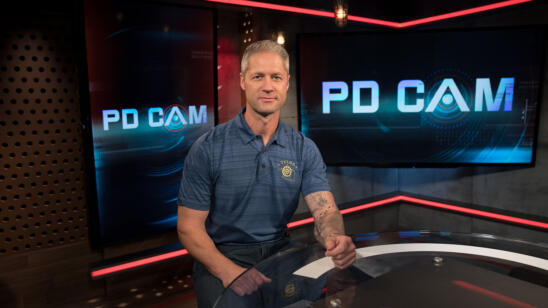Early morning on January 11, 2019, Angeline Hartmann, the media director at the National Center for Missing and Exploited Children (NCMEC) was driving in to work. The news that missing Wisconsin girl Jayme Closs was found alive had just broken the day before and Hartmann could not contain herself.
“I live kind of far from work, and I’m talking on the phone, driving…” she says. “All of a sudden I hear [siren noise]. It was an unmarked police car.”
As the officer asked Hartmann for her license and registration, she did her best to explain why she was driving over the speed limit—and on the phone. “I was like [breathless], ‘I’m just trying to get into work because Jayme Closs was found, and it’s just so exciting so I apologize,’ I said. ‘She’s been missing for three months and nobody knew where she was! And now she’s found and she’s OK!’ And he’s just standing there while I’m speaking a mile a minute, saying, ‘License and registration, please.'”
Ultimately, Hartmann earned herself a warning, and ended the conversation by bursting into tears—because of Closs, not the police encounter. “I didn’t mean to cry but it was really the first time I was saying it out loud and processing it, and it was so emotional. I was not just [crying] little tears, it was an ugly cry.”
As part of her role at the center, Hartmann appears on Live PD’s “Missing” segments, where she introduces details about a missing or exploited child to the show’s audience each week. (And yes, a number of success stories have come out of this partnership already.)
Hartmann worked with Live PD analyst Tom Morris Jr. and executive producer Kara Kurcz during her years as a correspondent and producer on the long-running show America’s Most Wanted, and she hosts the podcast “Inside Crime.” Hartmann spoke with A&E True Crime about the NCMEC’s response to the Jayme Closs news, misconceptions about missing children cases and the single most valuable tool in being able to find missing kids.
How did you and your colleagues at NCMEC respond when you first heard that Jayme Closs was alive and found?
We were ecstatic—shocked, happy, and just stunned all at the same time. This is something we always hope for, that the child survives whatever the situation is and is safely recovered. It was a moment I can only compare to my days at America’s Most Wanted, when a fugitive was captured as a direct result of being on the show, and we would ring a bell.
Once you were able to digest the news, how did you follow up as an organization?
We wanted to engage with the public immediately. A lot of times people will hear things, and they come to us to verify [them].
Once we confirmed, we immediately went to social media and our website and [released] a statement. People are looking for our reaction. They want to know what we think, how we feel. Our official statement was, basically, “Jayme Closs is the reason why we’re here—cases like this.”
Who do you hear from when news like this breaks?
It’s a barrage of media requests, usually. They come in from all over the country—not just Wisconsin [where Jayme is from], but every small town, every big town in the country, wants to know—is there a missing child in my area who we can [cover]? It gives renewed life to a case in their area that hasn’t had attention for a long time.
How do you respond?
During the first few hours, with something like [the Closs case], law enforcement isn’t saying much because they’re still working out the details. News media will come to us to figure out how they can fill in the blanks in an appropriate way. We obviously can’t talk about the investigation, [but] what we can talk about is what this means to families that are still looking for missing children. Because while it’s a day of rejoicing and happiness that Jayme Closs is home, it’s also an emotional time for other families. They [might be] just as happy, but they’re also hoping for that same kind of day to happen to them.
You do the “Missing” segments each week on Live PD. How do the children who are covered there get selected?
Sometimes police come to us and ask us to profile a missing child; sometimes families come to us—maybe they’ve seen a prior segment—and [ask], Can you profile my child? So first, we vet the cases here. We look at the cases that will benefit the most from the attention of Live PD. Every case is different and sometimes it will benefit from media attention, and sometimes, depending on the circumstances, it’s not the right timing. It just depends on what’s happening in that particular investigation.
We usually come up with a few different suggestions and then we consult with the Live PD producers.
How does social media play into the search for missing children?
Social media, especially for Live PD‘s audience, works really well for our missing children because this audience wants to spread the word so quickly and they want to share as much as they can. They know what they do can help bring a missing child home.
Are there any drawbacks to such a strong response?
Sometimes we have to reign it in. For example, after a child is found, [people who have been following the story] want answers. They want to know what happened, where she was found, how he was found, the details. But we have to remember, these are children we’re talking about, and there are a lot of sensitivities. We can’t always explain what exactly happened. It’s not for us to say.
How do you usually hear from the audience?
They tend to tweet me directly, and say, Hey, that thing I just heard on this channel, is that in fact true? And they expect an answer pretty quickly! I have not seen that before. There is a different type of social media connection with the Live PD audience. Tom [Morris Jr.] always says, they feel the love on their end, but here at the NCMEC, we feel that energy when [fans] share a poster. And I personally feel that connection.
What would you say is the single most productive or helpful element of finding missing kids today?
The number one tool in finding a missing child is having a good, current picture of that child. And then we need people to look at it, take the time to share it. Those things, working hand in hand, really make a huge difference in bringing a child home.
What are some misconceptions about most missing children cases?
One of the huge misconceptions is sometimes people don’t look at runaway cases as they would other cases. Runaways are very vulnerable to trafficking situations, so to think a child who has run away is not in a dangerous situation is a fallacy.
Also, one of the biggest misconceptions is that if they’re with a parent, they must be OK. It doesn’t matter what circumstances are behind the situation. A missing child is a missing child, and that missing child needs your help.
Why did you want to do your podcast, “Inside Crime with Angeline Hartmann”?
What makes it into an article [or on-air report] is only a little bit of what the real conversation was. I wanted to tell those stories about law enforcement, from [their] perspectives. I wanted to be able to give family members of missing children or family members of crime victims the opportunity to say what they wanted to say—things that might not necessarily make the new headlines.
The idea is to get inside the crime, get more in depth with the people behind it, those people who were affected by it, whether we’re talking about crime victims, law enforcement, or people who report on these crimes.
In the recent season finale of the podcast, you interview John Walsh, the creator of America’s Most Wanted and co-founder of NCMEC. You talked about how many people are simply not aware of the center and all that it does, even in law enforcement. What should people know?
We have a whole team that handles unidentified children. People would be surprised to know that there are more than 700 cases of unidentified remains—children’s remains. That means somebody stumbled upon remains, that child is dead, and we still have not figured out who that child is. The center works with law enforcement, different agencies, to figure out what it can do to help identify that child.
There’s [also] the side of the house that deals with the exploitation of children. For people who suspect that child exploitation is happening, we have a tip line they can call. Our teams get images of children being exploited all day long, and try to figure out who those children are and who the bad person is who is sharing those images, who created those images, who’s distributing those images. These are things people don’t want to think about, so it’s tough to talk about. But people need to know that the National Center for Missing and Exploited Children is here because we’re a resource—not just for families, but for law enforcement.
For more information, call the NCMEC’s 24-hour hotline: 1-800-THE-LOST (1-800-843-5678) or visit their CyberTipline.
Related Features:
How ‘Live PD,’ AMBER Alerts and Social Media Have Helped Find Missing Children
The ‘Boy in the Box’: Will 2019 Be the Year We Get Answers About the Famous Unsolved Murder?
Cleveland Kidnapping Survivor Michelle Knight: Healing After 11 Years in Hell


